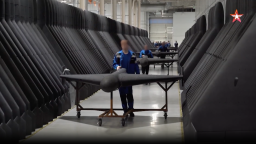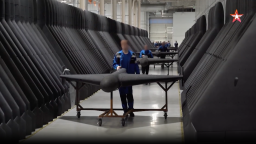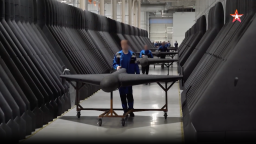Science
Russia Expands Drone Production, Marginalizing Iran’s Role

Russia has established a significant drone production facility, further integrating the Iranian-designed Shahed-136 attack drone into its military operations. The factory, located in Alabuga, Tatarstan, approximately 600 miles east of Moscow, has ramped up production, signaling a shift in the relationship between Moscow and Tehran.
During a recent documentary, CEO Timur Shagivaleev highlighted Alabuga’s capabilities, noting that most components for the Shahed-136 are now produced locally. “This is a complete facility,” Shagivaleev stated, emphasizing the local production of engines, microelectronics, and fuselages. Analysts estimate that about 90% of the drone’s production stages now take place in Russia, underscoring the factory’s role in Moscow’s drone campaign against Ukraine.
Recent satellite images indicate that Alabuga is expanding, with new facilities and dormitories to support increased production. Analysts suggest this growth may enable Russia to export an upgraded version of the Shahed-136, potentially even back to Iran. However, a Western intelligence source has pointed out that this expansion marginalizes Iran, revealing a growing rift between the two nations.
Tehran’s frustration stems from its perceived lack of return on investment in the partnership. Iran has provided support to Russia, including drones and missiles, but has received limited military backing in response to threats, particularly during Israel’s recent bombing campaign targeting Iranian nuclear facilities. According to Ali Akbar Dareini, an analyst at the Tehran-based Center for Strategic Studies, Iran expected more decisive support from Russia, which has not materialized.
The relationship between Russia and Iran has evolved into one of both cooperation and competition. As Russia localizes production of the Shahed-136, it appears to be reducing its reliance on Iranian technology and control. The shift is indicative of Russia’s broader strategy to master the production cycle and diminish the need for negotiations with Tehran.
After Russia’s full-scale invasion of Ukraine in February 2022, it began importing Shahed drones from Iran. By early 2023, Moscow had signed a $1.75 billion deal to produce these drones domestically. Initial contracts called for the manufacture of 6,000 drones by September 2025, but Russia has reportedly exceeded expectations, producing over 5,500 units monthly, according to Ukraine’s Defense Intelligence.
Cost efficiency has also improved; the price of a Shahed-136 drone has dropped from an average of $200,000 in 2022 to approximately $70,000 in 2025. Furthermore, reports indicate that the drones have been upgraded with enhanced communication systems, longer-lasting batteries, and larger warheads, making them more lethal.
While Iran initially welcomed the localization of production, the rapid upgrades by Russia have taken Tehran by surprise. A Western intelligence official noted that this evolution represents a gradual erosion of Iran’s control over the final product. The official emphasized that Russia’s actions reflect a “purely transactional” partnership, where Moscow prioritizes its immediate interests.
As the situation develops, Iran may seek to bolster its military capabilities through enhanced operational support from Russia. This could include increased weapons shipments, technological sharing, and intelligence cooperation.
The recent ceasefire between Israel and Iran has allowed Tehran to regroup following the conflict that targeted its nuclear capabilities. Analysts, including David Albright, a former UN weapons inspector, suggest that Alabuga’s expansion could enable Moscow to provide Iran with updated Shahed drones to replenish its stockpiles.
On July 11, 2023, a military cargo plane operated by Gelix Airlines was tracked flying from Moscow to Tehran, raising questions about potential military equipment transfers. While Iranian media claimed the plane carried components of an S-400 air defense system, CNN has been unable to verify the cargo.
Despite the tensions in their relationship, analysts believe Iran will ultimately benefit from its partnership with Russia. Dareini remarked that Iran would continue to receive essential military hardware, economic cooperation, and technological advancements, underscoring the complexity of the strategic alliance between these two nations.
-

 Lifestyle3 weeks ago
Lifestyle3 weeks agoBelton Family Reunites After Daughter Survives Hill Country Floods
-

 Technology3 weeks ago
Technology3 weeks agoDiscover the Top 10 Calorie Counting Apps of 2025
-

 Education4 weeks ago
Education4 weeks agoWinter Park School’s Grade Drops to C, Parents Express Concerns
-

 Technology2 weeks ago
Technology2 weeks agoHarmonic Launches AI Chatbot App to Transform Mathematical Reasoning
-

 Technology4 weeks ago
Technology4 weeks agoMeta Initiates $60B AI Data Center Expansion, Starting in Ohio
-

 Technology4 weeks ago
Technology4 weeks agoByteDance Ventures into Mixed Reality with New Headset Development
-

 Lifestyle4 weeks ago
Lifestyle4 weeks agoNew Restaurants Transform Minneapolis Dining Scene with Music and Flavor
-

 Technology3 weeks ago
Technology3 weeks agoMathieu van der Poel Withdraws from Tour de France Due to Pneumonia
-

 Technology3 weeks ago
Technology3 weeks agoRecovering a Suspended TikTok Account: A Step-by-Step Guide
-

 Technology3 weeks ago
Technology3 weeks agoGlobal Market for Air Quality Technologies to Hit $419 Billion by 2033
-

 Health4 weeks ago
Health4 weeks agoSudden Vision Loss: Warning Signs of Stroke and Dietary Solutions
-

 Technology4 weeks ago
Technology4 weeks agoTrump Faces Internal Struggles Over Epstein Files Handling





















